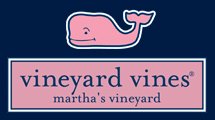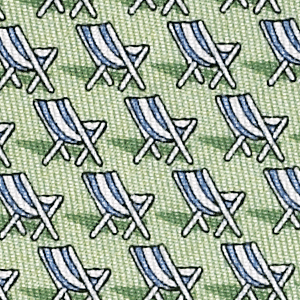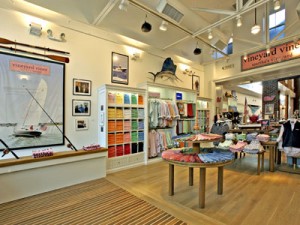 Vineyard Vines is everywhere. A classic American success story, the company, most associated with whimsical yest office compatible ties, was most recently feted in the long-anticipated follow up to The Original Preppy Handbook – TRUE PREP.
Vineyard Vines is everywhere. A classic American success story, the company, most associated with whimsical yest office compatible ties, was most recently feted in the long-anticipated follow up to The Original Preppy Handbook – TRUE PREP.
In fact, TRUE PREP and TOPH author Lisa Birnbach worked together to promote the new book. In September, Vineyard Vines used its stores to host a cross-country tour for Ms. Birnbach and even launched a TRUE PREP co-branded capsule collection. As it did not even exist when TOPH was written, this example of Vineyard Vine’s impact on, and influence in, the East Coast preppy trend is even more noteworthy.
The Back Story
Founded in 1998, Vineyard Vines sells a classic vision: that everyone should enjoy the simple New England seaside life; and through their products you can. In times like these, still full of turmoil and uncertainly and a desire for simple, classic influences, that message is very attractive.
Vineyard Vines was built by two brothers, Shep and Ian Murray, who both had suit-and-tie Manhattan careers but really wanted to live and play by the water. They quit, started making quirky ties and the rest, as they say, is history. Self financed by the seat of their pants, it’s an authentic story. And the company’s hats, ties, shirts, short and bags all carry this inherent authenticity that resonates with Vineyard Vines’ customers.
 Though host to a variety of product lines, the most well known are their ties which have a similar cache’ to Hermes ties and so are regularly snapped up by suit wearing lawyers, bankers and even politicians.
Though host to a variety of product lines, the most well known are their ties which have a similar cache’ to Hermes ties and so are regularly snapped up by suit wearing lawyers, bankers and even politicians.
This particular aspect of the company’s brand is one of its most interesting. While VV ties are not made in a French artisan’s atelier, their similar subtle repetitive patterns, rendered tongue-in-cheek to Hermes’ status-heavy bridle bits, often resonate with the same customer demographic.
As Ian says, “We started making neckties so we didn’t have to wear them.” That feeling has effectively translated to their customers. For many, wearing a Vineyard Vines tie is a little like saying, “I may have to wear a tie, but I’m wearing a vineyard Vines tie because that’s who I really am – someone who doesn’t need to wear a tie.”
 Vineyard Vines’ ties send a message about the wearer, or at least what the wearer wants you to believe about him. Their designs are tastefully neutral but topically ironic. As noted above, where Hermes may have interlinking Raj elephants, Vineyard Vines ties have interlinking beach chairs or gin & tonics. They are statement ties at a very irreverent level and in fact require the wearer to possess some personal confidence; a little “in-your-faceness.”
Vineyard Vines’ ties send a message about the wearer, or at least what the wearer wants you to believe about him. Their designs are tastefully neutral but topically ironic. As noted above, where Hermes may have interlinking Raj elephants, Vineyard Vines ties have interlinking beach chairs or gin & tonics. They are statement ties at a very irreverent level and in fact require the wearer to possess some personal confidence; a little “in-your-faceness.”
To my mind, one of the main reasons that Vineyard Vines remains a successful brand, even during these economically challenging times, is because its growth and brand recognition were both the result of an organic process. It’s grown slowly in terms of a national label and by doing so has achieved a certain cult status among the American preppy/Trad cognoscenti.
The brand and its products have a personal and timelessly classic appeal. Most companies spend small fortunes trying to manufacture that magic – Shep and Ian just seemed to stroll right into it. But once the brand stuck, they made a point of effectively managing its growth and sticking to their natural markets.
Branding the Life
At its core, Vineyard Vines can still be considered a cult brand. While its product lines are fairly strait forward New England preppy standbys – polos, khakis, shorts, fleece, tote bags – the buzz surrounding the company is still the visceral kind normally associated with newcomers. Not everyone knows about the brand, but those who do are often vocal advocates.
 For a lot of their customers, sporting a Vineyard Vines martini glass tie or whale logoed hat, tells people that really they are an individual, not one of the corporate masses. And within the company, there is still a real passion to spread the gospel of Vineyard Vines. With products and price points that range from hundreds to just a few dollars, it’s also a lifestyle brand that people can buy a little piece at a time. This approach is the classic recipe for retail success practiced by the likes of Louis Vuitton and Ralph Lauren.
For a lot of their customers, sporting a Vineyard Vines martini glass tie or whale logoed hat, tells people that really they are an individual, not one of the corporate masses. And within the company, there is still a real passion to spread the gospel of Vineyard Vines. With products and price points that range from hundreds to just a few dollars, it’s also a lifestyle brand that people can buy a little piece at a time. This approach is the classic recipe for retail success practiced by the likes of Louis Vuitton and Ralph Lauren.
From the customer’s perspective, moving through the Vineyard Vines world is well thought out presented at a casually human scale. Everything reinforces not only the “VV” lifestyle but also the real people living it. For example, the catalogs feature real people whom the brothers have known for years, not professional models. This practice began out of necessity – they couldn’t actually afford to hire models – but eventually became a staple of the local and real world ethos that has made the brand so popular and accessible.
Over the past few years, there has been some validity to complaints that Vineyard Vines was on design autopilot. The styles were a little drab and neutral and quality not top-notch. The 2010 Summer and Fall seasons however, have been absolutely on target. The designs are inspired and appealing in a functionally preppy way and a renewed focus on materials and construction show.
OTC recently received a box full of Vineyard Vines’ current offerings and I can say that, unexpectedly, I love each piece. to be blunt, I did not expect to be so impressed. Given the generally average stylistic and performance reviews the brand gets, I was hoping to find one or two pieces for OTC to recommend. Turns out, it all gets a big OTC thumbs up.
 The two pullovers they sent, a Raft Up Rugby and Jersey 1/4-Zip (in Blue Blazer), are without exception my new go-to favorites. The Washed Twill Club Pants (in Beach) were, honestly, the biggest surprise.
The two pullovers they sent, a Raft Up Rugby and Jersey 1/4-Zip (in Blue Blazer), are without exception my new go-to favorites. The Washed Twill Club Pants (in Beach) were, honestly, the biggest surprise.
I tried out VV pants before and was disappointed. They never really fit me and I felt like the leg openings were too wide – just not me. On top of that, I’m a bit of a khaki snob, mostly because I can never find a pair that I really fits me. These khakis, rendered in a lightweight brushed finish vaguely reminiscent of moleskin, are great. I wear them all the time and I’m going to get more; simple as that.
The Nor’easter Vest, lined in dense but thin Polartec has already seen extensive dog walking and apple picking use. In speaking with the company’s PR crew I learned that, although not really touted, Vineyard Vines outer wear is genuinely tough and built for use. No, walking the dog is not akin to heeling your 420 in 15-foot swells during a squall, but the taped seams, heavy zippers, durable materials and solid construction appear to be some new hallmarks for a brand that has heretofore been categorized as “style over substance.”
Bricks & Mortar
In its stores, Vineyard Vines has done the elusive – effectively capturing the appeal of coastal New England life and tying the physical experience to emotional appeal of the brand. In fact, while other brick-and-mortar outlets are closing or at least slowing their expansion, VV is still moving ahead with targeted expansion.
The stores are friendly, bright and inviting. You feel the Nantucket-ness in every inch of the place; from the large framed maps of New England coastline to the buoys and nautical paraphernalia scattered across the selling floor. For a native Connecticut Yankee who spent childhood summers on Long Island Sound, it’s like going home.
 Of course, it’s a clean, shiny, well designed nautical version of home akin to Polo’s take on the classic English country manor house. Better and more ideal than the real thing but nonetheless inherently true to its roots.
Of course, it’s a clean, shiny, well designed nautical version of home akin to Polo’s take on the classic English country manor house. Better and more ideal than the real thing but nonetheless inherently true to its roots.
On the cyber end of things, the website is visually engaging and makes the visitor feel like they are part of the Vineyard Vines world, or at least that should want to be. There is even a photo gallery so that customers can send pictures of their exploits and celebrations while wearing or using Vineyard Vines products. This last feature is a very effective method for building brand personalization and identification because the customer is literally getting to be part of the culture. It also marries traditional “real world” marketing with aspects of social media and first person reporting.
Shep and Ian also recently launched their blog, which highlights a more conversational approach to the brand. In fact, what it really pushes is a community approach to content generation. they want the blog to populated by fan stories, posts or videos of local and family events sent in by customers and employee highlights from retail outlets.
In Part II of this extended brand profile, we’ll continue our discussion about Vineyard Vines’ business strategy, including their successful approach to college grassroots marketing, its political connections and creative model for retail development. Part II is working its way through editing and should be ready in a week or two. Keep your whale hat on and your eyes peeled.
I really like this company and have several VV items, including of course ties, sport shirts, and shorts. A nice success story.
To me, they’re a copy cat brand…and it’s tough to be “classic” when you were founded in 1998. Every item they sell is, essentially, a knock off of other more established brands, from the faux Murray’s Reds to the bad copy Leatherman Ltd belts…even the motif ties have been done by others for decades. They’re great marketers to be sure, but for my money, I’d rather spend it on a brand with established quality and heritage….and an ounce of originality. Oh, and the logo is far too cartoonish….don’t want it smiling away on any of my gear.
It’s hard to find your page in google. I found it on 20 spot,
you should build quality backlinks , it will help you to get more visitors.
I know how to help you, just type in google – k2 seo tricks